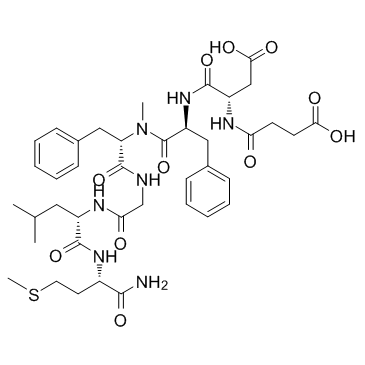Succinyl-(Asp6,N-Me-Phe8)-Substance P (6-11)
Modify Date: 2024-01-02 14:36:53

Succinyl-(Asp6,N-Me-Phe8)-Substance P (6-11) structure
|
Common Name | Succinyl-(Asp6,N-Me-Phe8)-Substance P (6-11) | ||
|---|---|---|---|---|
| CAS Number | 106128-89-6 | Molecular Weight | 841.97000 | |
| Density | 1.29 g/cm3 | Boiling Point | 1262.6ºC at 760 mmHg | |
| Molecular Formula | C40H55N7O11S | Melting Point | N/A | |
| MSDS | N/A | Flash Point | 717.4ºC | |
Use of Succinyl-(Asp6,N-Me-Phe8)-Substance P (6-11)Senktide is a tachykinin NK3 receptor agonist. |
| Name | Senktide |
|---|---|
| Synonym | More Synonyms |
| Description | Senktide is a tachykinin NK3 receptor agonist. |
|---|---|
| Related Catalog | |
| Target |
NK3 receptor[1] |
| In Vitro | The selective NK3 receptor agonist Senktide excites 24 of 31 dopaminergic neurons in the substantia nigra pars compacta in a concentration-dependent manner. The effective concentration range is between 3 to 3000 nm. The mean EC50 for Senktide is 41.2±9 nm (n=5)[2]. |
| In Vivo | I.c.v. injection of Senktide causes a dose-dependent increase in total distance traveled (F6,72=6.344, P<0.001). This increase reaches statistical significance compare to the vehicle-treated group at 0.06 nmol and higher. The Senktide-induced increase in locomotor activity brought about by 0.1 nmol of Senktide is significantly and dose-dependently decreased by the tachykinin NK3 receptor antagonists talnetant at 30 mg/kg and SB222200 at 30 mg/kg, but not by osanetant, when tested in parallel in a single experiment (F7,78=10.32, P<0.001), although a non-significant reduction is observed. However, when tested using another vehicle (Vitamin E and glycofurol), osanetant does decrease activity significantly compare to Senktide-treated gerbils (F2,30=10.10, P<0.001)[1]. |
| Cell Assay | Experiments are performed on brain slices (300 μM thick) from 150 g male Wistar rats and extracellular recordings are made by conventional techniques. Drugs (including Senktide) are applied by bath perfusion and removal is achieved simply by returning to the control drug-free solution. Extracellular electrodes are filled with aCSF and have resistances of 5 to 14 MΩ. For intracellular recordings, electrodes are filled with 1 M potassium acetate and have d.c. resistances of 70 to 110 MΩ. Neurons are considered to be dopaminergic if they have a characteristic waveform, slow firing rate (~5 Hz) and inhibitory response to dopamine[2]. |
| Animal Admin | For the Senktide dose-response curve, gerbils are first allowed to habituate to the test area for 30 min. Animals (n=10 to 12 per drug treatment group) are anesthetized with isoflurane, a small incision is made in the skin over bregma, and an injection of Senktide at 0.01, 0.03, 0.06, 0.1, 0.3 or 0.6 nmol in 5 μL of vehicle is placed i.c.v. using a syringe with a 4.5 mm long needle. Wounds are clipped shut, and animals allowed to awaken from anesthesia, then placed directly into the locomotor activity boxes and recording commenced. For testing of the NK1 receptor antagonist aprepitant (1, 3 or 10 mg/kg p.o.), gerbils are first treated with aprepitant or vehicle (0.9% NaCl with 0.3% Tween80) and returned to the home cage for 90 min. Animals are then placed in the open field for 30 min of habituation. During the last 5 min of habituation, 0.03 nmol Senktide is injected i.c.v[1]. |
| References |
| Density | 1.29 g/cm3 |
|---|---|
| Boiling Point | 1262.6ºC at 760 mmHg |
| Molecular Formula | C40H55N7O11S |
| Molecular Weight | 841.97000 |
| Flash Point | 717.4ºC |
| Exact Mass | 841.36800 |
| PSA | 317.59000 |
| LogP | 2.99010 |
| Vapour Pressure | 0mmHg at 25°C |
| Index of Refraction | 1.579 |
| Storage condition | -20°C |
| RIDADR | NONH for all modes of transport |
|---|
|
Neurokinin B signaling in the female rat: a novel link between stress and reproduction.
Endocrinology 155(7) , 2589-601, (2014) Acute systemic stress disrupts reproductive function by inhibiting pulsatile gonadotropin secretion. The underlying mechanism involves stress-induced suppression of the GnRH pulse generator, the funct... |
| suc-asp-phe-n-me-phe-gly-leu-met-nh2 |
| succinyl-asp-phe-me-phe-gly-leu-met-nh2 |
| m.w. 842.1 c40h55n7o11s |
| Suc-DF-(NMeF)-GLM-NH2 |

